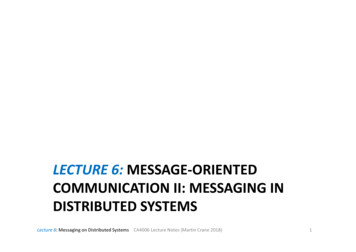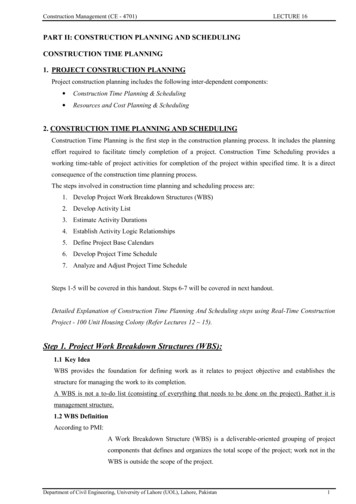
Transcription
Project ManagementLecture 6 Project Planning and NetworkDiagramsDr. Andre Samuel
Previous Lecture Project Charter:– Purpose– Main Element– Template
In this Lecture Planning Process Network Analysis/Critical Path Analysis
‘The Plan is nothing, Planning iseverything’Lord Nelson and General Eisenhower
Planning It is about sequencing project activities and milestones into asensible and logical order It involves linking activities to form a project network to showhow different activities are related to each other Planning will establish the timing of the activities and resourcerequirements
Purpose of Planning Its is used to find the expected project duration and milestonedates It is used to make sure that the project is completed by atarget date e.g. opening of the Olympic Games To get stakeholder commitment
The Planning ProcessIdentifyActivitiesPresent Planin a readilyintelligibleformatPrepare Estimatesof Time andResourcesDetermineSequence ofactivities
Identifying Activities Scope of works– WBS
Project Scope Management Scope management is mandatory; without scope managementthere is no project “ensuring that enough, but only enough, work is undertaken todeliver the project’s purpose successfully” Turner (1999, pg.93) Through the process of managing the scope the owner’srequirements are converted first into the definition of the newasset Secondly, into a statement of the work required to constructand commission that asset
In the project context scope may refer to:– Product scope‐ the features and functions that characterize aproduct or service– Project scope‐ the work that must be done to deliver a product withthe specified features and functions
Scope of Works‐ Point Fortin Highway
Point Fortin Highway
Construction of Valencia to Toco f
Construction of Valencia to Toco Road: Packages1 to ��for‐valencia‐to‐toco‐upgrade Phase 1 is separated into 4 packages which consist of:– The construction of a roundabout at Valencia Junction along withassociated concrete and drainage works; Improvement of drainagenetwork North of Valencia Junction– Milling and paving from the Intersection of Eastern Main Road andToco Main Road to the 2km mark along the Toco Main Road;Construction of a car park inclusive of a perimeter fence and relocationof the vegetable stall– Road widening and reconstruction along with associated drainageworks from the 2km mark to the 3.5km mark– Road widening and reconstruction along with associated drainageworks from the 3.5km mark to the 5.0km mark inclusive of slopestabilization at 4.2km mark
Phase 2 is also separated into 4 packages which consist of:– Road widening and reconstruction along with associated drainage andconcrete works from the 5km mark to the 6.5km mark along theValencia Main Road; Construction of a roundabout at Chainage 5 950 tofacilitate a controlled intersection in anticipation of the forthcomingOjoe Connector Road– Road widening and reconstruction along with associated drainage andconcrete works from the 6.5km mark to the 8km mark inclusive of slopestabilization at 6.6km mark– Road widening and reconstruction along with associated drainageworks from the 8km mark to the 10km mark– Road widening and reconstruction along with associated drainageworks from the 10km mark to the 12.4km.
San Fernando to Princess Town H/way
Overall Scope of Works
Project Duration and Phasing
WBS‐’Chunking’ Hierarchical tree of all the tasks needed to complete a project Each level progressively gets more and more detailed until thebottom level is reached which shows all the smallest day today tasks Maps out a view of Project Stages, Phases, Work Packages,Activity ,Tasks or Steps
Group Discussion Using the Scope of Works document for the Guava,Point Fortin Project:– Discuss the major tasks and sub task to complete the project– Visualize what the WBS would look like.
Example WBS
Project scope statement includes the following: Product scope description‐ Progressively elaborates thecharacteristics of the product, service, or result described inthe project charter and requirements documentation. Acceptance criteria ‐ A set of conditions that is required to bemet before deliverables are accepted. Deliverable ‐ Any unique and verifiable product, result that isrequired to be produced to complete a process, phase, orproject.
Project exclusion ‐ Generally identifies what isexcluded from the project. Explicitly stating whatis out of scope for the project helps to managestakeholders’ expectations. Constraints ‐ for example, a predefined budget orany imposed dates or schedule milestones thatare issued by the customer or performingorganization
Scope Change Control Scope Creep‐ subtle changes made to product withoutapprovals All change request should be documented and evaluatedagainst the project constraints Essentially, an impact assessment The assessment will determine whether or not the changewould be implemented Use change request forms, change control log
Tasks Dependencies‐ sequencing activities A relationship between two linked tasks Linked by a dependency between finish and startdates Defining task dependencies correctly results in aschedule that's easy to maintain regardless of whathappens or how quickly There are four types of dependency: Finish to Start,Start to Start, Finish to Finish and Start to Finish
Chronology vs Control Although tasks are called either successors orpredecessors, a dependency is not really aboutchronology, but about control. A task dependency specifies which of two taskscontrols the scheduling of the other. The independent task (the predecessor) determinesthe scheduling of the dependent task (the successor). A predecessor can occur before, at the same time as,or after its successor.
Task dependencies vs Date Constraints Applying dependencies to tasks is preferable to setting harddates in a schedule. Fixed dates applied to tasks, called date constraints, quicklyincrease the effort to maintain the schedule. If you use date constraints, you often must manuallyrecalculate dates when the schedule changes. However, date constraints don't always cause scheduleproblems. For example, when tasks occur on specific dates, such astraining classes or conferences, date constraints keep thoseevents tied to the correct dates on the calendar.
Finish‐to‐start (FS) This type of dependency is the most common,perhaps because control and chronology work in thesame direction in this dependency. After thepredecessor task finishes, the successor task starts. This means activity A must finish before activity B haspermission to start For example:– After members of a construction crew set up the concreteforms for a foundation, they start to pour the concrete intothe forms.
Start‐to‐start (SS) This type of dependency indicates that the start of one tasktriggers the start of the second task. A lag time between tasksis often used with this type of dependency. This means that once activity A has started, activity B can alsostart. For example:– Members of a road crew start to place traffic cones to close a lane onthe highway. Ten minutes (lag time), after they start the line‐paintingmachine starts to paint lines.
Finish‐to‐finish (FF) This type of dependency includes one task thatcontinues only as long as another task is in progress. This means activity A must finish before activity B canfinish For example:– Traffic flaggers direct traffic until construction work iscompleted.– In a software project, two programmers may be working ontwo different modules. If module B makes use of module A,then module B cannot be completed until the firstprogrammer has completed module A.
Start‐to‐finish (SF) This type of dependency turns most people's conceptof predecessor and successor tasks upside down. Theconfusion occurs because in most start‐to‐finishcases, the predecessor occurs after the successor. So,the start of the predecessor controls the finish of thesuccessor. This means that as long as A has started, we canproceed to finish B. Activity A must start before Activity B can finish.
Examples of S‐F Say you’re building a new gas pipeline. You would firstfinish construction and implementation of the newpipeline before you would begin shutting down andbreaking down the old pipeline Similarly, implementation of a new accounting systemhas to be completed before you can begin turning offthe old system The start of the new shift of the security guard signalthe finish shift of the current security guard. ie. if thenext shift security guard didn't turn up, the first shiftsecurity guard has to continue his duty.
Lead Time‐ is overlap between tasks that have a dependency.– For example, if a task can start when its predecessor is half finished,you can specify a finish‐to‐start dependency with a lead time of50 percent for the successor task. You enter lead time as a negativevalue in MS Project.
Lag Time‐ is a delay between tasks that have a dependency.– For example, if you need a two‐day delay between the finish of onetask and the start of another, you can establish a finish‐to‐startdependency and specify two days of lag time. You enter lag time as apositive value in MS Project
Project Planning Tools Network Diagram (Critical Path Analysis) Gantt Charts
Network Diagrams Network diagram show the relationships between activities They are used to:– calculate the Project Duration– Reveal critical tasks which warrant greater management attention
Activity of Node Method In this approach each activity of the project is represented by aNode i.e. an activity box. Dur Duration in time unitsEST Earliest Start TimeEFT Earliest Finish TimeLST Latest Start TimeLFT Latest Finish Time
Labels for Activity Box EST‐ The earliest point in time when the scheduleactivity can begin EFT‐ The earliest point in time when the scheduleactivity can be complete LST‐ The latest point in time when the scheduleactivity can begin so as not to delay the projectcompletion date or any constraint. LFT‐ The latest point in time when the scheduleactivity can finish so as not to delay the projectcompletion date or any constraint.
Dependency Table for a Software ProjectIDTASK NAMEDURATIONPREDECESSORS1A1 CLIENT WORKSHOP10‐2A2 CASE MODEL1513A3 USER REVIEW1024B1 Db DEFINITION1025B2 FORMS DESIGN2046B3 REPORT DESIGN53,57C1 SYSTEM TESTING2058C2 HANDOVER TO CLIENT56,7
Network Diagram
Two Parts to the Analysis Forward Pass– Calculates the Duration of the Project Backward Pass– Calculates the slack/float for each task and shows the critical path
Forward Pass to calculate EST and EFT The EST for the first activity is zero EFT for an activity is always found by adding its duration to its EST. i.e.EFT EST Duration The EST for all remaining activities is the same as the EFT of itsimmediate predecessor i.e. EST EFT of preceeding activity In the case of convergence, the EST is taken from the pathhaving the highest EFT The EFT of the last activity is the duration of the project
Forward Pass
Reverse Pass to calculate LST and LFT The LFT for the last activity is the same as its EFT The LST for an activity is always found by subtractingits duration from its LFT i.e.LST LFT – Duration The LFT for all remaining activities is given by the LSTof its immediate successor i.e.LFT LST of the successor activity (moving from startto finish) In case of convergence, the LFT is taken from thepath having the lowest LST
Reverse Pass
Float/Slack This is the spare time for an activity This means that a certain amount of delay can betolerated without affecting the expected projectduration
Types of Float/Slack Total Float‐ Total float is the period by which an activitycan shift in its timing without affecting the relevantschedule completion date (either a constraint, or theproject completion). Free Float‐ Free float is the period by which an activitycan shift in its timing without affecting the Early Startof any succeeding activity or event.
Calculating Float Float/Slack LST – ESTOR LFT ‐ EFT
Float/Slack
Defining a Critical Task A critical task is one where EFT LFT. Thinking thisthrough it means that the activity MUST start on thatdate , the EST or the entire project duration isaffected Simply put an activity is Critical when the Float 0 A non‐critical task is where EFT LFT. This meansthat although the activity could start as early as theEST, providing it finishes by the LFT the project couldstill finish on schedule
Defining the Critical Path Critical Path‐– The critical path is the longest sequence of activities fromcommencement to completion of the project– The critical path is the series of tasks (or even a single task) thatdictates the calculated finish date of the project.– That is, when the last task in the critical path is completed, theproject is completed.– It is identified by the series of task where the Float or Slack is ‘Zero’
Importance of Network Analysis Critical activities must stay on schedule as they are most likelyto cause delays Project managers must concentrate their time on these tasks Conversely, knowing the float for non‐critical activities will letthe project manager know how long they can be delayed forbefore impacting the entire project.
Project Crashing This means adding resources to one or more critical pathactivities In the short term this may actually reduce productivitybecause of the learning curve effect Crashing incurs additional cost, but must be weighed upagainst finishing late
Fast Tracking Shortening the project duration by overlapping projectactivities or phases Perform critical path tasks in parallel that were originallyplanned sequentially
http://www.youtube.com/watch?v jO8syXdZoh0
Optimizing through Resource Levelling andSmoothing When you assign resources (staff) to a project itcan often lead to over allocation or staff conflict For example resource A is assigned to an activityon Project XYZ on a day, for 8 hours. This resourceis also allocated to Project LMN for 8 hours in aday Or resource A is assigned to work on multipleactivities on a project occurring at the same time How do we resolve this?
Resource Levelling A technique in which start and finish dates are adjusted basedon resource constraints with the goal of balancing demand forresources with the available supply This involves removing the over allocation of resources. Thiscan be done by:– Delay certain task– Assign a different resource– Change task dependencies
Resource Smoothing Resource smoothing means the uniform distribution ofresource allocation over the project Let's say that you have a resource working 30hours this week, 10 hours next week, and 20hours the week after next week. When you applyresource smoothing, the resource will work 20hours this week, 20 hours next week, and 20hours the week after. You see, the total amount ofhours remains 60 hours, but is more uniformlydistributed over the weeks.
Levelling and Smoothing Scenario
How to shorten project duration? Project crashingFast TrackingResource Levelling and SmoothingRe‐scoping‐ reduce scope to reduce timeIncreased procurement‐ outsource workLean thinking – redesign work processesRenegotiate target dates if possible
Network Diagram (Critical Path Analysis) Gantt Charts. Network Diagrams Network diagram show the relationships between activities They are used to: - calculate the Project Duration -Reveal critical tasks which warrant greater management attention . Dependency Table for a Software Project ID TASK NAME DURATION PREDECESSORS










